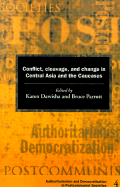Book contents
- Frontmatter
- Contents
- List of tables
- List of contributors
- Preface
- 1 Perspectives on postcommunist democratization
- 2 Democratization and political participation: research concepts and methodologies
- The Caucasus
- Central Asia
- 6 Democratization and the growth of political participation in Kazakstan
- 7 Kyrgyzstan: the fate of political liberalization
- 8 Thwarted democratization in Tajikistan
- 9 Turkmenistan: the quest for stability and control
- 10 Political development in Uzbekistan: democratization?
- Appendix
- Index
6 - Democratization and the growth of political participation in Kazakstan
Published online by Cambridge University Press: 01 June 2011
- Frontmatter
- Contents
- List of tables
- List of contributors
- Preface
- 1 Perspectives on postcommunist democratization
- 2 Democratization and political participation: research concepts and methodologies
- The Caucasus
- Central Asia
- 6 Democratization and the growth of political participation in Kazakstan
- 7 Kyrgyzstan: the fate of political liberalization
- 8 Thwarted democratization in Tajikistan
- 9 Turkmenistan: the quest for stability and control
- 10 Political development in Uzbekistan: democratization?
- Appendix
- Index
Summary
Kazakstan is an accidental country, a nation that was carved out of a Soviet republic whose boundaries were never intended to be those of an independent state. Independence has shaped the nature of Kazakstan's politics, and not always in ways that are supportive of democratic principles. Although the home of one of the first glasnost-era popular protests, the Almaty riots of 1986, prior to independence Kazakstan did not make the same strides towards democratization that neighboring Kyrgyzstan did. While independent political groups were organized, they lacked real influence on the political process.
Partly this was a reflection of fears that multinational Kazakstan could become an ethnic tinderbox if the republic's nearly equal numbers of Kazaks and Russians were to turn on one another. Democracy was understood by many as synonymous with ethnic empowerment, and there were grounds for concern as the republic's first political groups were almost all organized along ethnic lines.
Yet another reason why those in power were eager to temper the pace of political reform was the vast potential wealth of the republic, and fear that it might elude their control. This was true during the Soviet era, when the battle was between Moscow and the republic elite as to how wealth was to be divided between the center and the periphery. It became even more true after independence, when political control brought with it the right to manage the privatization of the nation's resources.
- Type
- Chapter
- Information
- Conflict, Cleavage, and Change in Central Asia and the Caucasus , pp. 201 - 241Publisher: Cambridge University PressPrint publication year: 1997
- 12
- Cited by



